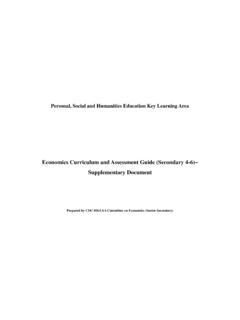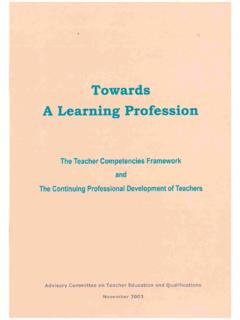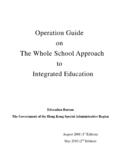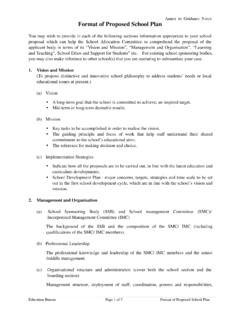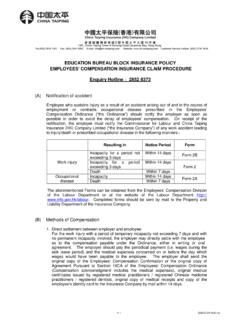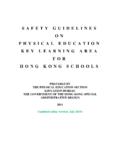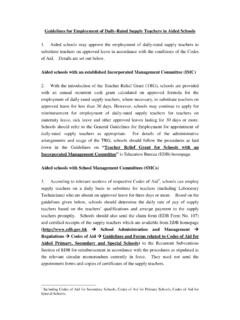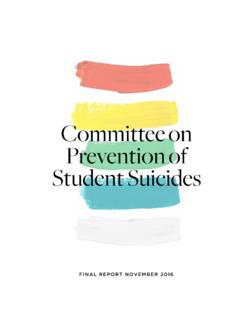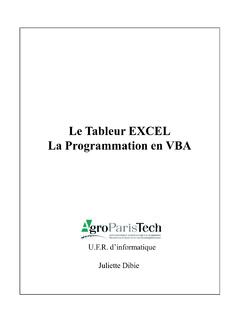Transcription of Resource Materials on the Learning and Teaching of Film
1 Resource Materials on the Learning and Teaching of Film This set of Materials aims to develop senior secondary students' film analysis skills and provide guidelines on how to approach a film and develop critical responses to it. It covers the fundamentals of film study and is intended for use by Literature in English teachers to introduce film as a new literary genre to beginners. The Materials can be used as a Learning task in class to introduce basic film concepts and viewing skills to students before engaging them in close textual analysis of the set films. They can also be used as supplementary Materials to extend students' Learning beyond the classroom and promote self-directed Learning . The Materials consist of two parts, each with the Student's Copy and Teacher's Notes. The Student's Copy includes handouts and worksheets for students, while the Teacher's Notes provides Teaching steps and ideas, as well as suggested answers for teachers' reference.
2 Part 1 provides an overview of film study and introduces students to the fundamentals of film analysis. It includes the following sections: A. Key Aspects of Film Analysis B. Guiding Questions for Film Study C. Learning Activity Writing a Short Review Part 2 provides opportunities for students to enrich their knowledge of different aspects of film analysis and to apply it in the study of a short film. The short film My Shoes has been chosen to illustrate and highlight different areas of cinematography ( the use of music, camera shots, angles and movements, editing techniques). Explanatory notes and viewing activities are provided to improve students' viewing skills and deepen their understanding of the cinematic techniques. While this set of Resource Materials is pitched at beginner level, references to websites and video clips that support further exploration are provided throughout the package.
3 The weblinks and URLs included were accurate at the time of dissemination but may be subject to change in the future. Teachers may make use of a search engine to regain access to any relocated resources or look for similar resources on the web. 1. Acknowledgements Special thanks are due to Nima Raoofi for permission to show shots from his film My Shoes in this set of Materials . 2. Part I. A. Key Aspects of Film Analysis Film is a genre which shares some common features of other literary texts ( a novel) and theatrical features of other performing arts ( a drama), while having unique cinematic features of its own. Literary aspects Dramatic/theatrical Cinematic aspects (as in a novel/short story) aspects (as in a play/drama). Plot (the story-line, Visualisation of action Framing/mise-en-sc ne development of (movement of the Camera angles (high events, narrative characters, stage angle, straight-on/.)))
4 Sequences and combat) and setting eye-level angle or low techniques, (stage design) angle shots). foreshadowing, Acting (actors' facial Camera position and flashback) expressions, actions distance (close-up, Characters and speeches) medium and long (protagonists, villains Costumes (clothing of shots). and heroes, round the characters) Camera movements and flat characters) Make-up and hairdo (panning, tilting, Point of view ( rolling). narrative voice and Editing (continuity perspective) editing, montage Setting (time and editing, cuts, fades). place where the story Lighting happens) Visual effects Theme (the subject Use of sound effects and music and ideas explored). Sub-genre (comedy, tragedy, science fiction, horror, suspense, romance). As film shares many features with other literary genres covered in the Literature in English curriculum ( prose fiction, drama), you should start analysing a film by bringing in your previous knowledge of textual studies and skills for literary 3.
5 Appreciation and critical analysis. It is important to realise the parallel features between film and the other literary genres while understanding how film appeals to the audience's sense of sound and sight more directly. B. Guiding Questions for Film Study The following guiding questions may help you examine the core elements of a film and form a basic understanding of the film you are viewing: Literary aspects: questions to consider 1. Who are the main characters in the film? 2. When and where is the film set? 3. What are the main plot elements? 4. Which is the most striking or exciting part in the film? 5. From whose point of view is the story told? 6. What is the theme or main message of the film? 7. What is the mood of the film? 8. What symbols are used in the film? 9. Does the film belong to a particular genre? Dramatic aspects: questions to consider 1.
6 Do the actors perform so well that you think the story is real? 2. How important are the costumes and make-up to the success of the film? 3. Are there any scenes particularly difficult to act? 4. How do the actors use their voice, speech/dialogue, body movement and facial expression to achieve the desired effects? 5. Do the actors establish their characters more through speech/dialogue or through body movement and facial expression? 6. Is there anything about the acting, set or costumes that you particularly like or dislike? 7. Do you recognise any particular style of the director? 8. How does the film compare to other films by the same director or other films of the same genre? Cinematic aspects: questions to consider 1. What visual images impress you the most? What do the images make you feel or think about? 2. Are there any scenes which use colours and lighting effectively to create the 4.
7 Desired effect? 3. What sound or music does the film use? What do they make you feel or think about? 4. Which part of the film has special or unusual editing? What impact does the editing have on the overall effectiveness of the film? 5. Are there other technical or special effects used in the film? Do they add to the overall effectiveness of the film? C. Learning Activity Writing about a Short Film Watch Ferdinand Dimadura's short film Chicken a la Carte , which was awarded The Most Popular Short Film in the Short Film Competition on the theme FOOD, TASTE &. HUNGER at the 56th Berlin International Film Festival in February 2006. The short film can be accessed at the URL below: As you are watching, note down what happens in the film, as well as the audio-visual effects in the template provided. Some examples have been provided for your reference: What happens Audio-visual effects Signboards of KFC, McDonald's, Jollibee Close-up to clearly show the brands and Chow King are shown before the of the fast food chains film title appears.
8 Mysterious and mystical music Two girls walk into the restaurant, look Tense drum sound at the menu, place their orders and wait for the food to be brought by the dumbwaiter. The two girls chat and giggle, while other customers line up to place orders. The girls eat little, leaving the restaurant with a lot of leftovers on their plates. A man travels on the road on a tricycle Mysterious and mythical music with a rubbish bin. again The man checks the leftovers in the rubbish bin and picks out some meaty pieces of chicken. 5. 6. With reference to the guiding questions in Section B, choose one of the following aspects of the film to focus on: Literary aspects Dramatic aspects Cinematic aspects Watch the short film a second time and focus on the aspect you will work on. Enrich your notes. Form groups of three, with each student focusing on a different aspect.
9 Share your general observations of the film with your classmates. Individually, write a few paragraphs on the chosen aspect of the film. You do not need to answer all the guiding questions listed in Section B and may select a few relevant ones to focus on. You should explain and elaborate on your points and offer personal responses with supporting details from the film. 7. PART 1 TEACHER'S NOTES. Warm-up Activities Before introducing film as a new genre and explaining the literary, dramatic and cinematic aspects to students, teachers may arouse students' interest and enthusiasm for talking about films with some of the following warm-up activities: Ask students to brainstorm what comes to their mind when they hear the word film ( Oscar, cinema, movie stars, Hollywood, director, box office, new releases). Show some film reviews on the latest box office hits taken from the Internet sources, newspapers or film magazines Play short clips of the Oscars or other film awards and events Ask students to talk about the last film they watched and what they like or dislike about it Ask students to think of a film that they would recommend to their classmates and share why this film is worth-watching Arrange a group visit to the cinema Make it clear to students that in the Literature in English subject, they need to go beyond passive entertainment to active study and in-depth analysis of a film.
10 It is not advisable to bombard students with a comprehensive list of technical film terminology at the early stage, as this can be intimidating to beginners. A. Key Aspects of Film Analysis To build on students' previous experiences and activate their prior knowledge, teachers may start by guiding students to think about the differences between a printed text ( a novel, a short story) and a non-print text ( a film, a drama performance). It would suffice at this stage if students can identify some of the following similarities and differences between printed and non-print texts. Similarities Printed texts ( a novel, a Non-print texts ( a film, a short story) drama performance). Common Subject matter/theme features/ Plot 8. elements Characters Point of view Setting Sub-genre Differences Printed texts ( a novel, a Non-print texts ( a film, a short story) drama performance).
